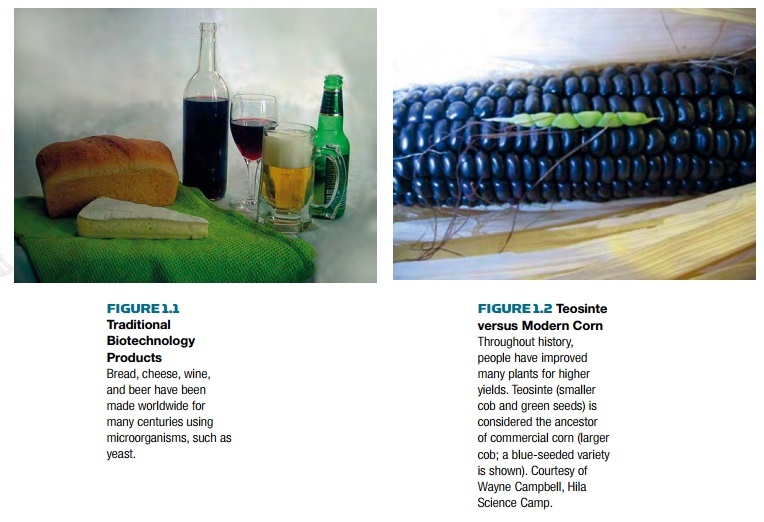Chapter: Biotechnology Applying the Genetic Revolution: Basics of biotechnology
Advent of the Biotechnology Revolution
Basics of
Biotechnology
ADVENT
OF THE BIOTECHNOLOGY REVOLUTION
Biotechnology involves the
use of living organisms in industrial processes—particularly in agriculture,
food processing, and medicine. Biotechnology has been around since the dawn of
time, ever since humans began manipulating the natural environment to improve
their food supply, housing, and health. Biotechnology is not limited to
humankind. Beavers cut up trees to build homes. Elephants deliberately drink
fermented fruit to get an alcohol buzz. People have been making wine, beer,
cheese, and bread for centuries. All these processes rely on microorganisms to
modify the original ingredients (Fig. 1.1). Over the ages, farmers have chosen
higher yielding crops by trial and error, so that many modern crop plants have
much larger fruit or seeds than their ancestors (Fig. 1.2).

The reason we think of
biotechnology as modern is because of recent advances in molecular biology and
genetic engineering. Huge strides have been made in our understanding of
microorganisms, plants, livestock, as well as the human body and the natural
environment. This has caused an explosion in the number and variety of
biotechnology products. Face creams contain antioxidants—supposedly to fight
the aging process. Genetically modified plants have genes inserted to protect
them from insects, thus increasing the crop yield while decreasing the amount
of insecticides used. Medicines are becoming more specific and compatible with
our physiology. For example, insulin for diabetics is now genuine human
insulin, although produced by genetically modified bacteria. Almost everyone
has been affected by the recent advances in genetics and biochemistry.
Mendel’s early work that
described how genetic characteristics are inherited from one generation to the
next was the beginning of modern genetics (see Box 1.1). Next came the
discovery of the chemical material of which genes are made—DNA (deoxyribonucleic acid).
This in turn led to the central dogma of genetics; the concept that genes made
of DNA are expressed as an RNA (ribonucleic acid) intermediary
that is then decoded to make proteins.
These three steps are universal, applying to every type of organism on earth.
Yet these three steps are so malleable that life is found in almost every
available niche on our planet.
Related Topics